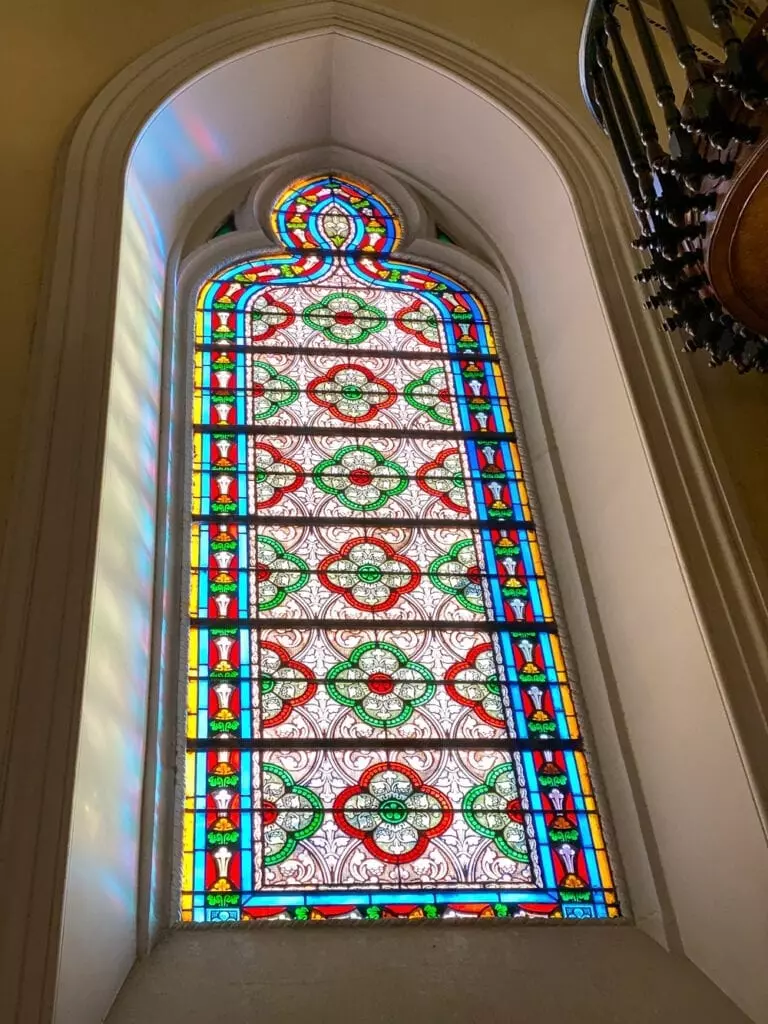Three mysteries surround the Miraculous Staircase at the Loretto Chapel in Santa Fe: who built it, the engineering behind its construction, and the materials used.
History of the Loretto Chapel
In 1869, Archbishop Jean-Baptiste Lamy hired two French architects Antoine Mouly and his son Projectus to construct the mother church of the Archdiocese of Santa Fe, the Cathedral Basilica of St. Francis of Assisi. Lamy allowed the Sisters to make use of the architect’s services on the side to construct a chapel for the Loretto Girls’ Academy. Projectus became the principal architect of the chapel, inspiring his design from the famous Sainte-Chapelle in Paris, with French imported stained-glass windows dominating the chapel. Officially consecrated in 1878, the chapel’s Gothic design featured spires and buttresses, with locally quarried sandstone. Projectus suddenly died in 1879 before completing access to the choir loft.

The Story of the Miraculous Staircase
The Sisters consulted several carpenters regarding stairway access to the choir loft, but all concluded that a ladder would take up less seating space in the chapel. To find a solution, the sisters prayed a novena to St. Joseph, the patron saint of carpenters. On the ninth and final day, a man appeared at the chapel with a toolbox and donkey looking for work. Several months later, the carpenter finished a remarkably elegant circular staircase, then quietly disappeared without pay or gratitude.
The carpenter built the 20-foot tall staircase with two 360 degree turns and no visible means of support, seeming to defy physics, using wooden pegs and glue, no nails. There were questions about the type of wood used as well as the number of stair risers relating to the height of the choir loft. The sisters viewed the finished staircase as a miracle and imagined the builder as St. Joseph himself.
The handrails were added later in 1887 by another craftsman Phillip August Hesch as well as an iron support bracket.

Engineering of the Staircase
One of the miracle aspects of the staircase is the lack of the newel or center pole usually constructed to support and stabilize a spiral staircase. The compact stair stringers or outer and inner stair sides twist into a helix or spiral. The inside stringer with overlapping segments joined by wood glue created a laminate, that initiated more substantial center support. The staircase held a significant amount of weight, based on a photograph taken about 1959 of at least a dozen choir members posing on the stairs. Ash, a wood not native to the area of Santa Fe, was used in the construction of the staircase. There were 33 stair risers, the age Jesus was when he died on the cross.

Identity of the Carpenter
In the early 2000s, amateur historian Mary Jean Cook found evidence of the probable carpenter as Francois-Jean “Frank” or “Frenchy” Rochas (1843-1894), who came to New Mexico from France around the 1870s. Cook also found an entry in the Sisters’ ledger, noting that Rochas was paid $150 for wood in 1881 (equal to $3,974 in 2019), confirming a construction job he performed. A short article in the Santa Fe New Mexican in early 1895 reported the murder of Rochas: “he was a Frenchman favorably known in Santa Fe as an expert worker in wood.” The article stated that he constructed the magnificent staircase in the Loretto chapel and a stairway at St. Vincent sanitarium. At his death, he owned a comprehensive set of carpentry tools, including a pair of trammel points for drawing large circles, saws, clamps, planes, gauges, chisels, braces, drills, bits, and a reamer.

Regarding the Miraculous Staircase, there are many amazing stories, TV specials, including “Unsolved Mysteries,” as well as a movie entitled “The Staircase,” starring Barbara Hershey and William Petersen.
Formerly a Roman Catholic Church serving the sisters of Loretto for their girls’ school, the church is now privately owned and used as a museum and a wedding chapel. A small entrance fee and profits from the gift shop help maintain the historic chapel.
